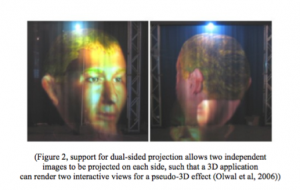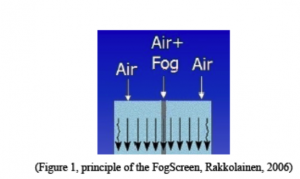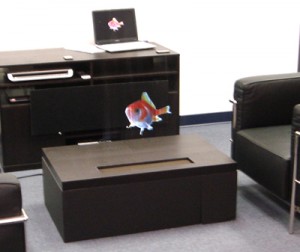PASS THROUGH DISPLAYS
Fog Screen
Displays that have appropriated immaterial properties have been documented and viewed since the Ornamental Fountain of the 19th Century. While performing water displays are more recently recognized from Water Dome, Aquatique Show, and Disney Fantasmic. [6]
FogScreen is just that, a 2D projection screen, but not a common opaque screen like hundreds of others in the market, rather an immaterial screen. The word immaterial in relation to display systems refers to those that create that sense of imagery floating in mid-air, usually created using water, smoke or fog.”[9]
The fog screen “harvests humidity in the air by condensing it into water, which is then broken into fog…The basic principle is the use of a large non-turbulent airflow to protect a flow of, for example dry fog particles inside it from turbulence. The outer airflow may get slightly turbulent, but the inner fog layer remains thin and crisp, enabling high-quality projections and the walk-through possibility. Ordinary tap water is broken into fine fog droplets and trapped inside this non-turbulent airflow. Even though the fog is made of water, it appears dry to the touch, just like air.” [6]
Results of the fog screen are most vivid when the air flow of the fog are less turbulent (tightly passed and quickly emitted by the device). Such attributes are being enlisted by the Heliodisplay.
Helio-Display
The Heliodisplay utilizes similar technology to the Fog display in respect to the production of a dry to the touch water particle for viewable purposes. The Heliodisplay presents an image with less fidelity because of a compact surface area for viewing (28 inches and 30 inches). [9]
For panorama architecture and for presentation elegance, the Helio-display provides a more advantageous directional emittance of the water particles and housing location. The housing of the Heliodisplay is floor bound and water particles rise rather than descend. For future panorama displays this provides an opportunity to create a screen emitter that is embedded in the floor, leaving the housing out of the consciousness of the viewer.
While presenting attributes unique to the display category, the Fog screen and Helio-display provide numerous complications for creating panorama environments. Initial expense from the purchase of multiple fog screens or a singular modification in the form of panorama environment greatly eclipses current projector and surface expenses. Currently pricing for an individual Helio-display is around $19,000.[24] Additional expenses can be attributed to the space needed to house the device (capabilities to supply water to the fog screen, custom construction for mounting the housing, lighting). Secondary considerations to the fog screen are: imperfect fidelity, sound distortion from housing of the projector and fog emitting device, segmented and variable visual content, large overhead device to house fog emitter, and affected by wind and bright lights.


